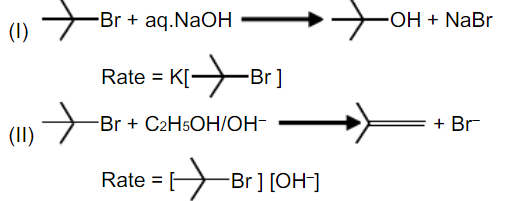Statement I Benzonitrile is prepared by the reaction of
chlorobenzene with potassium cyanide.
Statement II Cyanide (CN−) is a strong nucleoohile.
Both assertion and reason are correct and reason is the correct explanation of the assertion
Both assertion and reason are correct, but reason is not the correct explanation of the assertion
Assertion is correct but reason is incorrect
Assertion is incorrect but reason is correct
The correct Answer is:D
Assertion is incorrect but reason is correct.
Topper's Solved these Questions
- HALOGEN CONTAINING COMPOUNDBOOK - ERRORLESS CHAPTER - HALOGEN CONTAINING COMPOUNDEXERCISE - Critical Thinking (Reasoning type Questions)
2 Videos
- HALOGEN CONTAINING COMPOUNDBOOK - ERRORLESS CHAPTER - HALOGEN CONTAINING COMPOUNDEXERCISE - Critical Thinking (Comprehension type Questions)
6 Videos
- HALOGEN CONTAINING COMPOUNDBOOK - ERRORLESS CHAPTER - HALOGEN CONTAINING COMPOUNDEXERCISE - Ordinary Thinking Objective Question (Uses of Halogen containing compounds)
22 Videos
- GENERAL ORGANIC CHEMISTRYBOOK - ERRORLESS CHAPTER - GENERAL ORGANIC CHEMISTRYEXERCISE - Matrix Match type questions
4 Videos
- HYDROCARBONBOOK - ERRORLESS CHAPTER - HYDROCARBONEXERCISE - JEE SECTION (Matrix Match type questions)
6 Videos
Similar Questions
Knowledge Check
Statement I Benzonitrile is prepared by the reaction of
chlorobenzene with potassium cyanide.
Statement II Cyanide (CN−) is a strong nucleoohile.AStatement 1 is true, statement 2 is true, statement 2 is a correct explanation for statement 1BStatement 1 is true, statement 2 is true, statement 2 is not a correct explanation for statement 1CStatement 1 is true, statement 2 is falseDStatement 1 is false, statement 2 is trueAssertion (A) : Benzonitrile is prepared by the reaction of chlorobenzene with KCN.
Reason (R) : Cyanide (CN−) is a strong nucleophile.ABoth A and R are true and R is the correct explanation of A.BBoth A and R are true but R is not a correct explanation of A.CA is true but R is false.DA is false but R is false.
Correct statement regarding these two reaction I and IIARate of I reaction remain unchanged if concentration of OH− increases.BRate of II reaction remain unchanged if concentration of OH− increases.CRate of both reactions become double if concentration of OH− become doubleDRate of both reactions donot depend upon concentration of OH−
Statement I: Ti is prepared in an atmosphere of Argon not H2
Statement II: Ti dissolves H2 and becomes brittle.
View SolutionStatement I : Oxygen gas is easily produced at a faster rate by heating mixture of potassium chlorate and manganese dioxide than heating potassium chlorate alone .
Statement II : Manganese dioxide acts as a negative catalyst .
View SolutionStatement-1: Unsymmetrical ketone reacts with HCN to give (dil) mixture of carbohydrine.
Statement-2: Cyanide ion is amident nucleophile.
View SolutionStatement -1 :An original solution containing excess of Ni2+ ions gives a yellow coloured solution with potassium cyanide solution.
Statement-2 :A solution of Ni2+ ions gives red precipitate with dimethylglyoxime solution just made alkaline with ammonia.
View SolutionStatement-1 :Cu2+ and Cd2+ ions form complexes with excess of potassium cyanide solution.
Statement-2 : On passing H2S gas, complex [Cu(CN)4]3− is not effected but [Cd(CN)4]2− gives yellow precipitated.
View Solution
